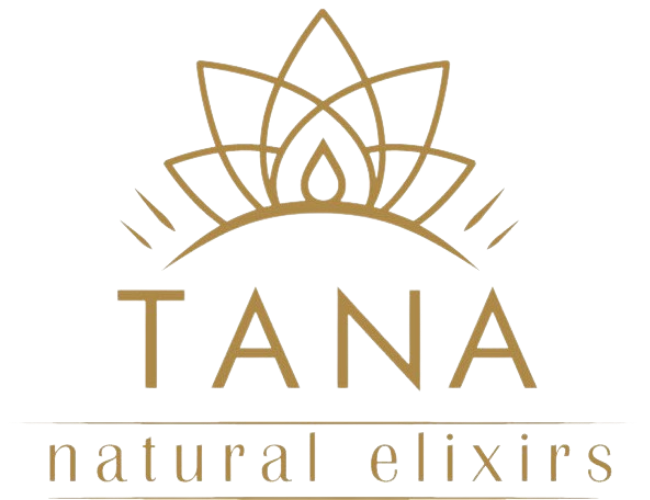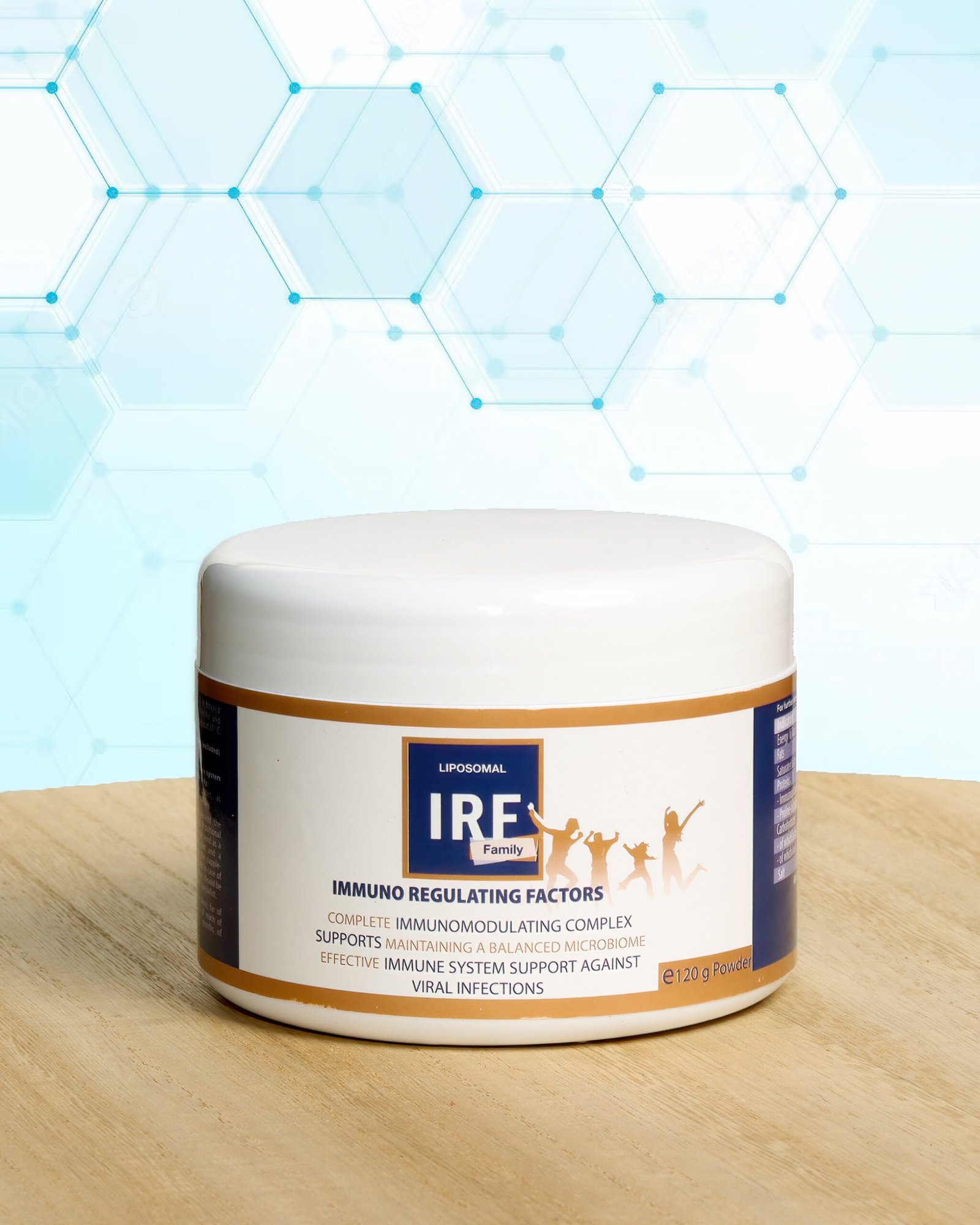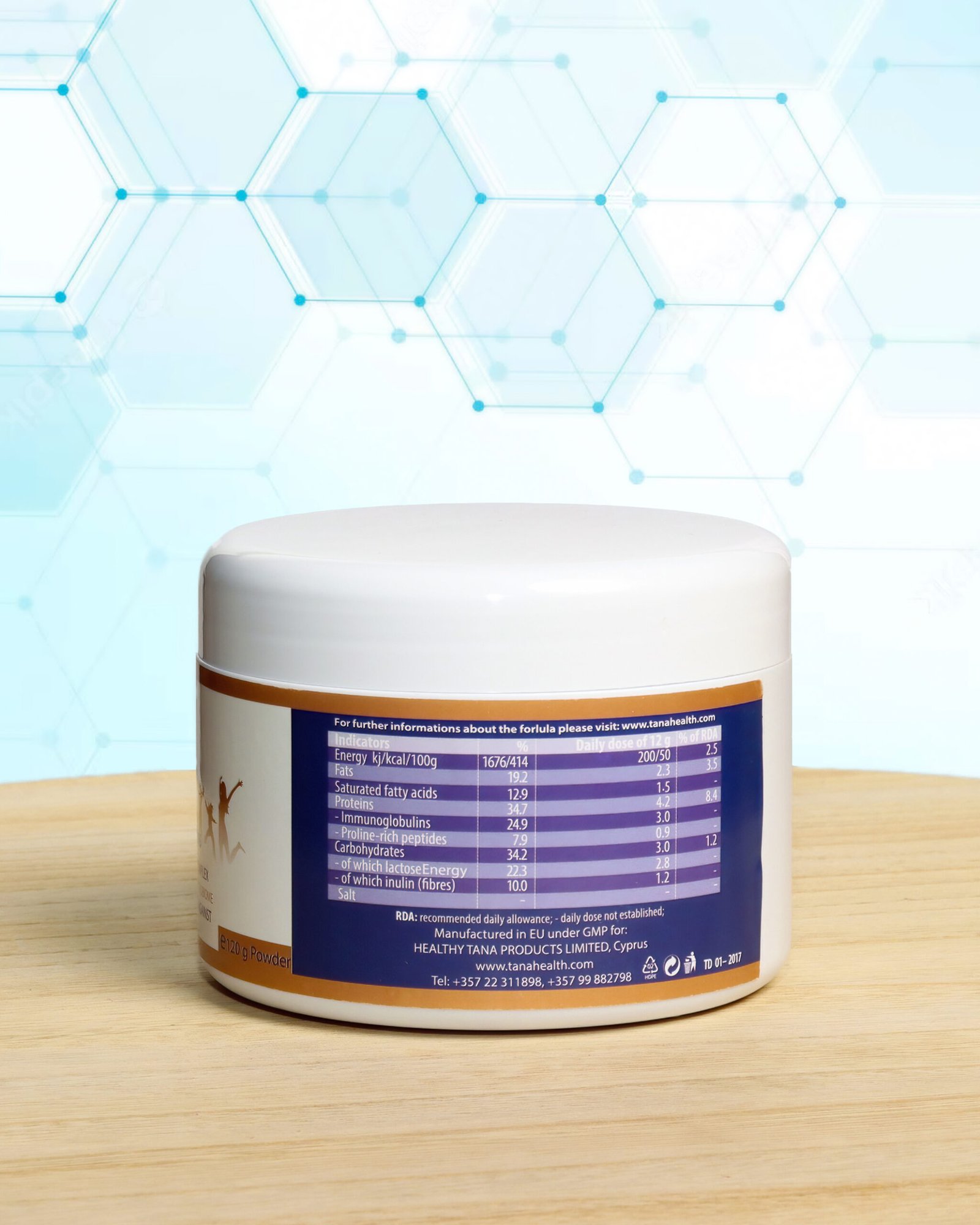A POTENT LIPOSOMAL ELIXIR FOR ORAL IMMUNOTHERAPY & AGING
What is it and how it works
IRF FAMILY is an original synergistic liposomal elixir based on Bulgarian buffalo colostrum. The exceptional beneficial properties of buffalo colostrum are enhanced by the addition of 3 natural components that contain potent immune – regulating factors. These natural components are chosen from a synergistic point of view, with specific potencies. This unique synergistic formula is manufactured using a patented, nano microencapsulation procedure (Innovation Certificate: IS No. 048/22.11.2016), to further increase the bioavailability of its components to finally end up in a special and potent ORAL IMMUNOTHERAPY & ANTI-AGING ELIXIR that:
- Restores immune function and helps in the establishment of optimal balance
- Destroys pathogenic microorganisms and helps eliminate them from the body
- Restores cell communication and function
- Stimulates tissue repair and regeneration
- Activates powerfully the activity of natural killer cells which destroy pathogenic organisms
- Activates the productivity of the antibodies providing prevention from diseases
- Increases cell strength, resistance and regeneration
- Slows down the general body aging process
- Stimulates the activation and differentiation of stem cells
Please check the ingredients to understand the potency of this exceptional supplement
What is it and how it works
IRF FAMILY is an original synergistic liposomal elixir based on Bulgarian buffalo colostrum. The exceptional beneficial properties of buffalo colostrum are enhanced by the addition of 3 natural components that contain potent immune – regulating factors. These natural components are chosen from a synergistic point of view, with specific potencies. This unique synergistic formula is manufactured using a patented, nano microencapsulation procedure (Innovation Certificate: IS No. 048/22.11.2016), to further increase the bioavailability of its components to finally end up in a special and potent ORAL IMMUNOTHERAPY & ANTI-AGING ELIXIR that:
- Restores immune function and helps in the establishment of optimal balance
- Destroys pathogenic microorganisms and helps eliminate them from the body
- Restores cell communication and function
- Stimulates tissue repair and regeneration
- Activates powerfully the activity of natural killer cells which destroy pathogenic organisms
- Activates the productivity of the antibodies providing prevention from diseases
- Increases cell strength, resistance and regeneration
- Slows down the general body aging process
- Stimulates the activation and differentiation of stem cells
Please check the ingredients to understand the potency of this exceptional supplement
When and who can use it?
(always consult your doctor before taking any nutritional supplement)
- IRF FAMILY can optimally supplement the nutritional plan before, during and after the surgery stage of malignant tumor treatment. It has a powerful regenerating effect during radiotherapy and chemotherapy. It restores and maintains the optimal immune system function and helps in overcoming the consequences of the disease and its aggressive treatment
- Can be used to control sick and cancer cells and decrease the risk of tumor formation.
- For optimization of immune system improving the resistance against the main viral, bacterial, fungal, yeast, allergic and parasitic diseases.
- For the maintenance of the optimum metabolic balance, which aids in the maintenance of all bodily functions and good physical and psychological state. Slows aging down.
- Supports the function of gastrointestinal system which is the base of all ailments according to the father of medicine Hippocrates
- Supports the weak organism of elder people, giving them strength and disease resistance
- Strengthens athletic performance, builds muscle mass and replenishes the body after exhaustive exercise or demanding periods of practice and exercise
- Excellent tonic during winter to fight cold, flu, viruses and other pathogens, and during the spring season to support the organism to control environmental allergens
- Helps students during exams and demanding periods by supporting neurological and mental functions
- General protection of the organism by reducing stress. It increases serotonin levels and decreases cortisol levels
- Helps in the regeneration of the epithelial layers of the skin which create youthfulness and support osteoporosis treatments
- Supports the appetite and helps in the maintenance of normal body weight
- Offers cardio protective, anti – inflammatory and blood sugar support
Recommended use
For optimal results, take the food supplement on an empty stomach (1/2 hour before or 2 hours after a meal) and, if possible, dissolve it in filtered water or water without chlorine and fluoride, at a temperature of about 37 ° C.
1 scoop is equal to 4 g (scoop included)
To maintain an optimal immune system and overall strengthen the body:
- Adults: 4 g in 100- 200 ml of water, as described above, 1 -3 times a day
- 12 – 17 years: 3-4 g in 100 – 200 ml of water, as described above, 1 – 3 times a day
- 6 – 12 years: 2-3 g in 100 – 150 ml of water, as described above, 1 -3 times a day
- 2 – 5 years: 1-2 g in 100 ml of water, as described above, 1 -3 times a day
For acute diseases:
- Adults: 8 g in 200 ml of water as described above, 3-5 times a day
- 12 – 17 years: 6-8 g in 200 ml of water, as described above, 3-5 times a day
- 6 – 12 years: 4-6 g in 150 ml of water, as described above, 3-5 times a day
- 2 – 5 years: 2-4 g in 150 ml of water, as described above, 1 -3 times a day
- We strongly suggest that if you need to create an even more powerful elixir, add 5ml of IRF2 SACRED OLIVE High Phenolic Extra Virgin Olive Oil in every dosage of IRF FAMILY
- Do not exceed the recommended daily dose. Nutritional supplements should not be used as a substitute for a varied diet and a healthy lifestyle.
- Avoid taking the supplement during pregnancy or breastfeeding.


Recommended use

For optimal results, take the food supplement on an empty stomach (1/2 hour before or 2 hours after a meal) and, if possible, dissolve it in filtered water or water without chlorine and fluoride, at a temperature of about 37 ° C.
1 scoop is equal to 4 g (scoop included)
To maintain an optimal immune system and overall strengthen the body:
- Adults: 4 g in 100- 200 ml of water, as described above, 1 -3 times a day
- 12 – 17 years: 3-4 g in 100 – 200 ml of water, as described above, 1 – 3 times a day
- 6 – 12 years: 2-3 g in 100 – 150 ml of water, as described above, 1 -3 times a day
- 2 – 5 years: 1-2 g in 100 ml of water, as described above, 1 -3 times a day

For acute diseases:
- Adults: 8 g in 200 ml of water as described above, 3-5 times a day
- 12 – 17 years: 6-8 g in 200 ml of water, as described above, 3-5 times a day
- 6 – 12 years: 4-6 g in 150 ml of water, as described above, 3-5 times a day
- 2 – 5 years: 2-4 g in 150 ml of water, as described above, 1 -3 times a day

Ingredients
Bulgarian Buffalo Colostrum and Cow colostrum fraction – proline-rich peptides (PRPs)
Buffalo and Cow colostrum contain over 90 components. Here are some of them
Proline-rich peptide (PRP). A hormone-like small protein that acts upon the thymus and other organs associated with the immune system to keep it from over-reacting to an insult. IRF1 contains a unique blend of PRPs from buffalo colostrum, cow colostrum and egg yolk. PRPs are transfer factors with key immunomodulating functions. They transfer information signals to the thymus for the production of the necessary cytokines depending on the nature of the relevant antigens. The most essential thing is that they recognize cancer cells as foreign antigens and initiate the production of native killer-cells against them, which explains their pronounced antitumor activity.
Thymosin (alpha & beta chains). A hormone composed of two protein-based chains that are separately present in bovine colostrum. The chains act on the thymus gland independently or in concert with each other to stimulate activation, development and maintenance of the immune system.
Immunoglobulins. Complex proteins, better known as antibodies, that make up a significant portion of the proteins found in complete first milking colostrum. These antibodies were produced by the mother’s immune system in response to her exposure to many different microorganisms during her lifetime and then transferred into the colostrum prior to birth of the calf. These antibodies offer protection against bacteria, viruses and fungi that infect the gastrointestinal tract of humans. IRF1 contains 5 types of immunoglobulins found in the colostrum – IgG, IgA, IgD, IgE and IgM, and one from the egg yolk – IgY
Cytokines. Small proteins produced by various cells in the body that induce the generation of specialized types of white blood cells, signal them to come to the site of an insult and help in their passage through tissues.
Conjugated linoleic acid. It has an important role in the metabolism of fatty acids, helps to improve immune system and has proven antitumor activity.
Lactoferrin. A mineral-binding carrier protein that attaches to available iron with proven anti-tumor properties. It also has antiviral, antibacterial and anti-inflammatory properties. Certain aerobic (grow in the presence of oxygen) bacteria, like E. coli, require iron to reproduce and, therefore, lactoferrin is an effective substance, when operating in the presence of a specific antibody, to impede the growth of some microorganisms in the gut.
Lactalbumin. A whey protein rich in tryptophan and cysteine, with high efficiency against some types of cancer and viruses. It increases brain serotonin, decreases cortisol levels and reduces stress.
Lymphokines. Proteins of varying sizes that are produced by different types of white blood cells that tell related cells to transform themselves into more functional cell types that can release substances capable of destroying an invading microorganism.
Transfer factors. Small proteins produced in response to the body’s exposure to certain types of microorganisms, particularly those that reside in deep tissues for a long period of time, like the bacterium that causes tuberculosis. They are specific for a particular microorganism and are carried inside of certain types of specialized white blood cells. Transfer factors have limited effectiveness alone in defending the body against infection by such microorganisms, but, rather, act in concert with various white blood cells and other factors in an attempt to keep the microorganisms under control.
Transferrin. Another mineral-binding carrier protein that attaches to available iron and can act independently or in concert with lactoferrin to impede the growth of certain aerobic bacteria, particularly in the gut.
White blood cells (leukocytes). Primarily, three types of functional white blood cells are present in colostrum, including neutrophils, macrophages and polymorphonuclear cells. Each has the ability to phagocytize (engulf) microorganisms and other foreign bodies and apply substances carried internally to the destruction of the microorganisms. Their functions are dramatically enhanced when antibodies first attach to the microorganisms.
Glycoproteins. They have inhibitory activity on proteases and trypsin, and protect the PRPs, immunoglobulins and growth factors from decomposition caused by proteolytic enzymes.
Lysozyme. A very powerful enzyme that is capable of attaching itself to the cell wall of certain pathogenic bacteria and degrading select components, leaving holes in the wall of the bacteria.
Xanthine Oxidase. Another mildly effective enzyme that can also attach to the wall of certain bacteria, degrade different proteins than those affected by lactoperoxidase and, therefore, also interfere with the ability of the bacteria to replicate themselves.
Oligosaccharides and glycoconjugates. Complex carbohydrates (sugars) that can adhere to specific sites on the inner surface of the gastrointestinal tract and prevent the attachment of microorganisms.
Lactoperoxidase. A mildly effective enzyme that can also attach to the wall of certain bacteria, degrade selected proteins and interfere with the ability of the bacteria to replicate themselves.
Insulin-like growth factors (IGFs). Insulin-like growth factor-1 (IGF-1) and its closely related counterpart insulin-like growth factor-2 (IGF-2) are potent hormones that are found in association with almost all cells in the body. They are part of a group of more than 90 different proteins, called the “IGF Binding Protein (IGFBP) Superfamily”, that is responsible for the processes by which cells grow and reproduce. These substances are also responsible for maintenance of the metabolic pathways in the body by which cells convert glucose to glycogen, a primary energy resource, and use amino acids to create proteins. The key event that triggers the functions of the various proteins in the IGFBP Superfamily is the attachment of IGF-1 to a specific site on the surface of a cell. Many of the growth factors found in colostrum and previously defined by their functions are now considered part of the IGFBP Superfamily. This includes the following substances, among others.
Transforming growth factors A & B. Induces the transformation of cells from an immature form to a mature, functional status.
Epithelial growth factor. Involved in the generation and maintenance of cells in the epithelial (outer) layers of the skin.
Fibroblast growth factor. Associated with the regeneration of various types of tissue, including skin and other organs.
Platelet-derived growth factor. Responsible for the generation of cells and functions associated with blood clotting.
Leptin. A small hormone-like protein that can suppress appetite and lead to body weight reduction. Mature fat cells (adipocytes) release leptin in the presence of insulin, which is also found in colostrum. Insulin-producing pancreatic beta-cells have binding sites for leptin and it is believed that the size of fat cells may be a major factor in determining the amount of leptin released. Therefore, leptin deficiency may be associated with obesity, particularly in diabetic individuals.
Insulin. A hormone required for the effective utilization of glucose (blood sugar) in the body. Insulin binds to specific sites on cells, facilitating their interaction with IGF-1 and, thus, initiating the conversion of glucose to glycogen, a high energy source carbohydrate.
Vitamin-binding proteins. Smaller proteins that act as carriers to deliver B-complex vitamins to the body. Carrier proteins and the associated vitamins folate (B6), B12 and orotic acid are found in colostrum.
Fat-associated vitamins. Significant quantities of vitamins A, D, E and K are dissolved in or associated with the fat in colostrum.
Mineral-binding proteins. The iron-binding proteins, lactoferrin and transferrin, have already been discussed above. In addition to interfering with the replication of certain microorganisms, they also serve to capture iron from the ingested food and present it in a form that can readily be absorbed by the body. Lactoferrin can also bind copper and deliver it in a form suitable for absorption by the body. In addition, there are two carrier proteins in colostrum that assist in the absorption of calcium. They are casein, which is also an abundant source of amino acids to build new protein molecules, and alpha-lactalbumin, which is present in colostrum very soon after birth.
Cyclic adenosine monophosphate (cAMP). A phosphorylated nucleotide in a very specialized form that transfers the chemical energy necessary to drive metabolic reactions to form new protein, carbohydrate and fat molecules.
Enzyme inhibitors. These small proteins slow down or inhibit the breakdown of proteins by certain enzymes. They provide limited protection to the immune, growth and metabolic factors as they pass through the digestive tract.
Hormone melatonin. Has a direct effect on the establishment of biological rhythms and proper sleep patterns.
Relaxin. A hormone known to directly affect contracted muscles.
Check the following references for (more…)
All humans host a community of at least 38,000,000,000,000 microorganisms that lives on us and in us. This community, the microbiome, performs very critical functions like digesting food, managing inflammation, boost immune system and produce important vitamins, neurotransmitters and metabolites. Modern life style, poor diet, antibiotics, tobacco, sugar, stress, decreased breastfeeding, alcohol and many other environmental factors, have depleted the diversity and richness of most people’s microbiome.
IRF FAMILY contains the following 7 different probiotic strains: Lactobacillus Bulgaricus, Lactobacillus Acidophilus, Lactobacillus Plantarum, Streptococcus Thermophilus, Bifidobacterium Bifidum, Bifidobactrium longum and Bifidobacterium infantis.
Check the following references for (more…)
Rich in immunoglobulin (IgY), specific bioactive peptides, Lutein, Zeaxanthin and other antioxidants, vitamins and minerals. It exerts anti-inflammatory, anti-microbial, anti-viral, anti-genic, anti-hypertensive, anti- cancer, antioxidant and immune-modulating properties.
Check the following references for (more…)
Helps to speed the healing process, lowers cholesterol, protects the heart, fights inflammation and stimulates the immune system with its antioxidant properties.
Check the following references for (more…)
Prebiotic: Inulin – fructooligosaccharide (FOS) to further help balance gut microbiome
(please check the research sector of the site for more information on health benefits)



